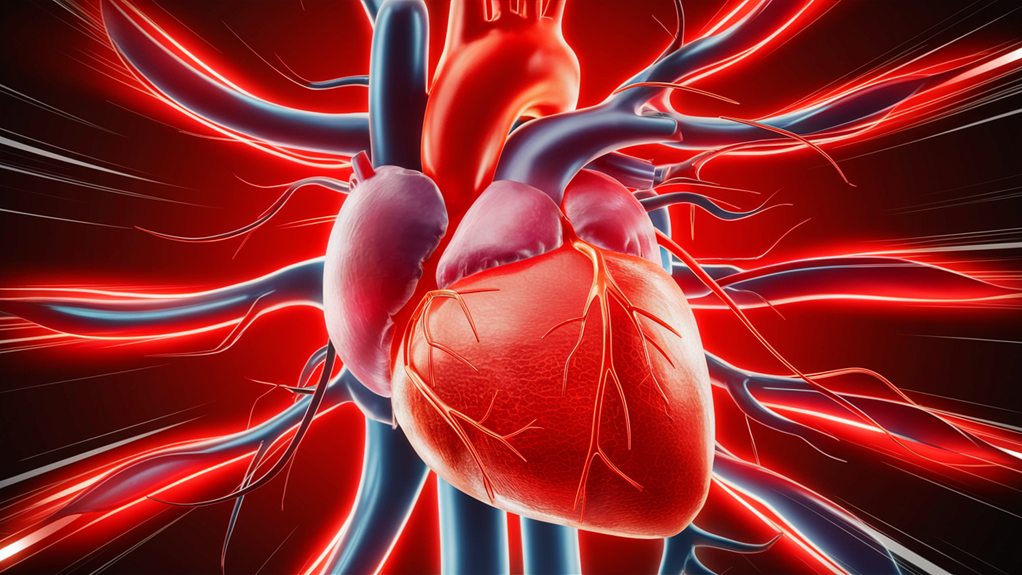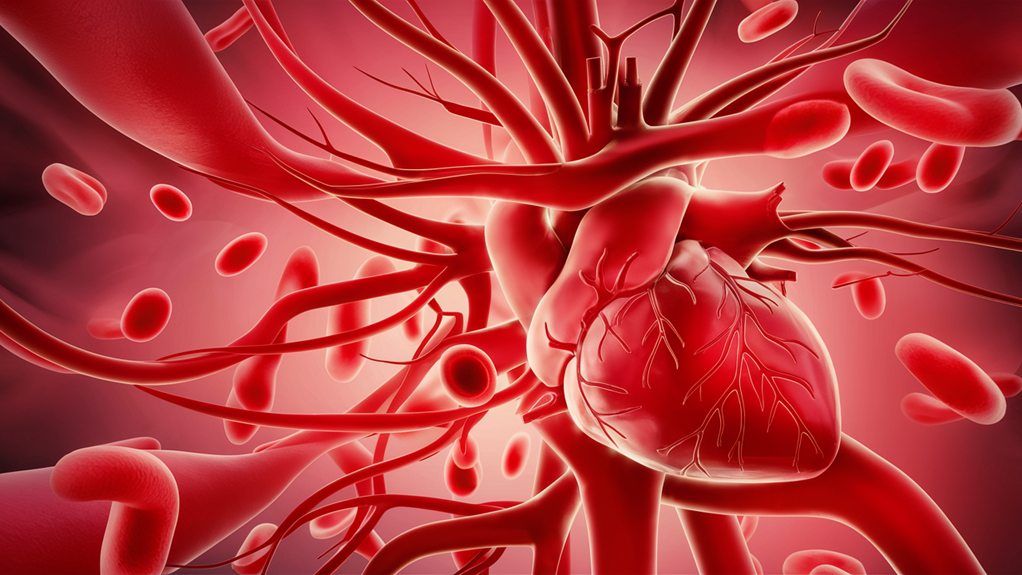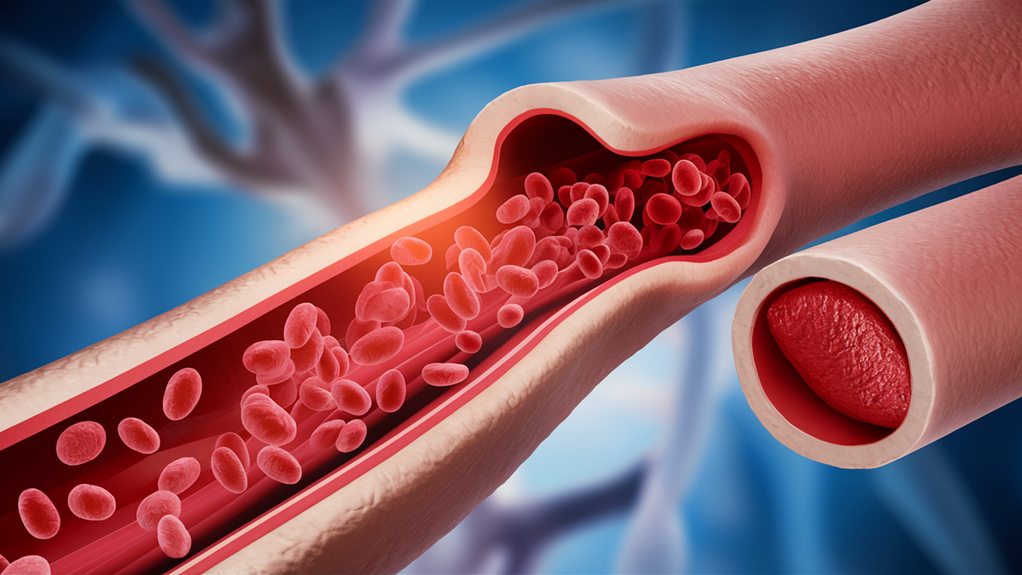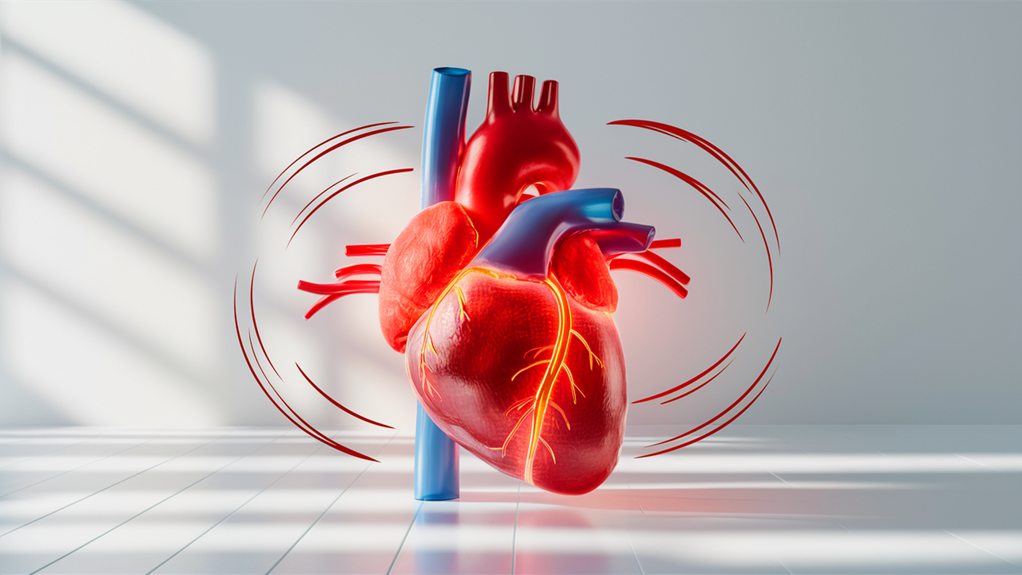Cardio exercise is one of the most powerful ways you’ll improve your heart health and overall well-being. When you engage in regular cardiovascular activities like brisk walking, swimming, or cycling, you’re strengthening your heart muscle, improving blood circulation, and lowering your blood pressure. You’ll notice benefits like a lower resting heart rate, better cholesterol levels, and enhanced blood vessel flexibility. Just 150 minutes of moderate cardio per week can reduce your risk of heart disease by up to 50%, while also boosting your endurance and energy levels. Understanding how to create an effective cardio routine will help you maximize these heart-healthy advantages.
What Makes Cardio Essential

Every single heartbeat matters when it comes to cardiovascular health. When you understand how cardio improves heart health, you’ll see why it’s non-negotiable for a strong heart. Your heart is a muscle that needs regular exercise to stay powerful and efficient, just like any other muscle in your body.
Engaging in cardiovascular exercise not only enhances your heart’s performance but also contributes to overall fitness and well-being, making it a significant aspect of a healthy lifestyle. Boost your health with cardiovascular exercise benefits highlights the extensive advantages of these workouts.
The benefits of cardio for cardiovascular health are extensive and life-changing. When you engage in cardio exercises, your heart learns to pump blood more effectively, delivering oxygen-rich blood throughout your body with less effort.
That’s why cardio is good for your heart – it strengthens the cardiac muscles, improves circulation, and reduces strain on this essential organ. You’ll notice that your resting heart rate becomes lower over time, which means your heart doesn’t have to work as hard during regular activities.
Cardio activities train your heart to handle physical demands more efficiently, whether you’re climbing stairs or playing with your kids. Your blood vessels become more flexible, blood pressure typically improves, and your body becomes better at managing cholesterol levels.
These adaptations help protect you against heart disease and other cardiovascular problems.
How Cardio Strengthens Your Heart

Through consistent cardio training, your heart undergoes specific physiological changes that boost its strength and efficiency. When you engage in regular cardio routines, your heart muscle becomes stronger, just like any other muscle that gets exercised. Not only does cardio improve your heart health, but it also plays a significant role in burning calories and aiding in fat loss, which can further enhance cardiovascular function and help in his role in weight loss. Your heart starts pumping more blood with each beat, which means it doesn’t have to work as hard during rest or physical activity.
As you continue with your heart health cardio routines, you’ll notice that your heart rate recovers more quickly after exercise, and you won’t get winded as easily during daily activities. Your heart’s chambers actually grow slightly larger, allowing them to hold and pump more blood with each contraction. This improved efficiency means your heart can deliver oxygen and nutrients to your body’s tissues more effectively.
The blood vessels throughout your body also become more elastic and develop more tiny branches, creating better circulation. You’ll develop more capillaries to support muscle tissue, and your body will produce more red blood cells to carry oxygen.
These adaptations work together to create a stronger, more resilient cardiovascular system that serves you better in both exercise and everyday life.
Blood Pressure Management Through Exercise

Regular cardiovascular exercise stands as one of the most effective natural methods for managing blood pressure levels. When you engage in activities like brisk walking, cycling, or swimming, your heart becomes more efficient at pumping blood, which helps reduce the pressure on your arterial walls.
Additionally, maintaining a balanced diet can further enhance these benefits, leading to improved energy and overall wellness, as noted in numerous health benefits. You’ll notice that your resting blood pressure begins to decrease after just a few weeks of consistent cardio training.
During your cardio workouts, your blood vessels become more flexible and elastic, allowing blood to flow more freely throughout your body. This improved circulation means your heart doesn’t have to work as hard to deliver oxygen and nutrients to your muscles and organs.
You’ll find that maintaining a routine of 30 minutes of moderate cardio, five days a week, can lower your systolic blood pressure by 4-9 points. When you combine regular exercise with other healthy habits, like reducing sodium intake and managing stress, you’re creating a powerful strategy for keeping your blood pressure in check.
Remember to start gradually and build up your exercise intensity over time, giving your cardiovascular system time to adapt to the increased activity.
Improved Circulation and Blood Flow

Improved Circulation and Blood Flow
Circulation benefits dramatically from consistent cardiovascular exercise, as your blood vessels expand and become more efficient at delivering essential nutrients throughout your body. When you’re exercising regularly, your heart pumps blood more effectively, and your blood vessels become more flexible, which helps oxygen reach every cell in your body.
Additionally, incorporating strength training can further enhance your cardiovascular health by promoting overall muscle growth, which helps improve your metabolism and aids in better blood circulation strength training benefits.
You’ll notice the positive effects of improved circulation in many ways, from warmer hands and feet to better muscle recovery after workouts. Your body’s natural healing processes work faster too, since increased blood flow helps deliver healing compounds where they’re needed most.
During cardio exercise, your smaller blood vessels, called capillaries, multiply and grow stronger, creating a more extensive network for blood delivery.
These circulation improvements don’t just happen during exercise – they’re long-lasting benefits that carry over into your daily life. When you maintain regular cardio workouts, you’re training your circulatory system to work more efficiently all the time.
This means your heart doesn’t have to work as hard to pump blood, and your organs receive better nourishment even when you’re resting.
Maintaining Healthy Cholesterol Levels

Engaging in consistent cardio exercise plays an essential role in managing your cholesterol levels, helping to raise beneficial HDL (good) cholesterol while lowering harmful LDL (bad) cholesterol.
When you perform activities like running, swimming, or cycling, you’re actively stimulating your body’s natural ability to balance these important blood lipids, which directly impacts your heart health. Additionally, incorporating strength training into your routine can enhance your overall fitness and metabolic rate, further supporting healthy cholesterol levels and promoting better cardiovascular function unlocking the power of strength training.
You’ll find that maintaining a regular cardio routine of at least 150 minutes per week can markedly improve your cholesterol profile. During exercise, your muscles rapidly use fatty acids for energy, which helps clear out excess cholesterol from your bloodstream.
What’s more, the increased blood flow from cardio activities helps your liver process cholesterol more efficiently, leading to better overall levels.
To maximize these benefits, you’ll want to combine moderate-intensity exercises, like brisk walking or dancing, with occasional high-intensity activities, such as interval training.
Each time you exercise, you’re not just burning calories but also triggering important metabolic changes that help your body maintain healthier cholesterol levels naturally, reducing your risk of heart disease and other cardiovascular problems.
Reduced Risk of Heart Disease

Scientific research consistently shows that cardio workouts can slash your risk of heart disease by up to 50 percent when performed regularly. Engaging in activities like brisk walking, swimming, or cycling not only strengthens your heart muscle but also enhances your stamina and circulation, which is particularly beneficial for seniors boosting heart health through fitness.
When you engage in these activities, you’re improving your heart’s ability to pump blood efficiently throughout your body. Your arteries become more flexible, and blood pressure typically drops to healthier levels.
You’ll notice that regular cardio sessions help your body manage inflammation better, which is essential since chronic inflammation can damage your blood vessels and contribute to heart disease.
As you maintain a consistent exercise routine, you’re also reducing the buildup of dangerous plaque in your arteries, decreasing your risk of blockages that could lead to a heart attack. Your body becomes better at using oxygen, and you’ll develop more tiny blood vessels that create alternate pathways for blood flow, giving your heart a backup system when it needs it.
Additionally, cardio exercise helps you maintain a healthy weight and reduces stress levels, both of which are significant factors in preventing heart disease.
Building Heart Rate Endurance

A steady progression in your heart rate endurance begins with consistent cardiovascular training. When you regularly engage in cardio exercises, your heart becomes more efficient at pumping blood throughout your body, allowing you to work out longer and harder without feeling exhausted.
Incorporating regular exercise not only aids in improving heart health but can also increase metabolism, which is vital for overall fitness. You’ll notice that as your heart rate endurance improves, activities that once left you breathless become more manageable. Your heart won’t need to work as hard during everyday tasks, and you’ll recover more quickly after physical exertion.
To build this endurance, you’ll want to start with 20-30 minutes of moderate cardio, 3-4 times per week, and gradually increase your duration and intensity.
Your heart rate zones play an important role in building endurance, so you’ll want to maintain a target heart rate between 60-70% of your maximum during workouts. As you progress, you can push this to 70-80% for shorter intervals.
Remember to track your heart rate recovery time, which will improve as your cardiovascular fitness increases, and listen to your body’s signals to avoid overtraining.
Types of Effective Cardio Workouts

Multiple types of cardio workouts can help you reach your heart health goals. You’ll find that some of the most effective options include brisk walking, jogging, swimming, cycling, and dancing, which all provide excellent cardiovascular benefits.
Incorporating high-intensity interval training (HIIT) into your routine can also be beneficial, as these quick HIIT workouts offer time-efficient exercises that can be completed in as little as 15-20 minutes. Each of these activities gets your heart pumping and can be adjusted to match your fitness level.
If you’re just starting out, you’ll want to begin with low-impact exercises like walking or swimming, which are gentle on your joints but still highly effective. As your endurance builds, you can progress to more challenging activities like running or high-intensity interval training (HIIT).
You’ll find that mixing different types of cardio throughout the week helps prevent boredom and works various muscle groups.
For indoor options, you can try jumping rope, using an elliptical machine, or taking group fitness classes at your local gym. These activities are particularly convenient during bad weather or when you’re short on time.
Remember to choose activities you enjoy, as you’re more likely to stick with exercises that bring you satisfaction while improving your heart health.
Creating Your Cardio Exercise Plan

Once you’ve explored different cardio activities, developing a structured exercise plan will help you maximize your heart health benefits.
Start by scheduling three to five cardio sessions per week, spacing them out to allow proper recovery time between workouts. You’ll want to begin each session with a 5-10 minute warm-up, which helps prepare your heart and muscles for exercise.
For beginners, it’s best to start with 20-minute sessions at a moderate intensity, where you can still hold a conversation while exercising. As your fitness improves, gradually increase your workout duration to 30-45 minutes, and incorporate intervals of higher intensity exercise.
You’ll know you’re working at the right intensity when your heart rate stays between 50-70% of your maximum during moderate sessions.
Remember to track your progress using a fitness app or journal, and adjust your plan every few weeks to prevent plateaus.
Don’t forget to include rest days, which are essential for recovery and preventing burnout. If you’re managing any health conditions, it’s important to consult your doctor before starting your cardio plan, ensuring it’s tailored to your specific needs.



